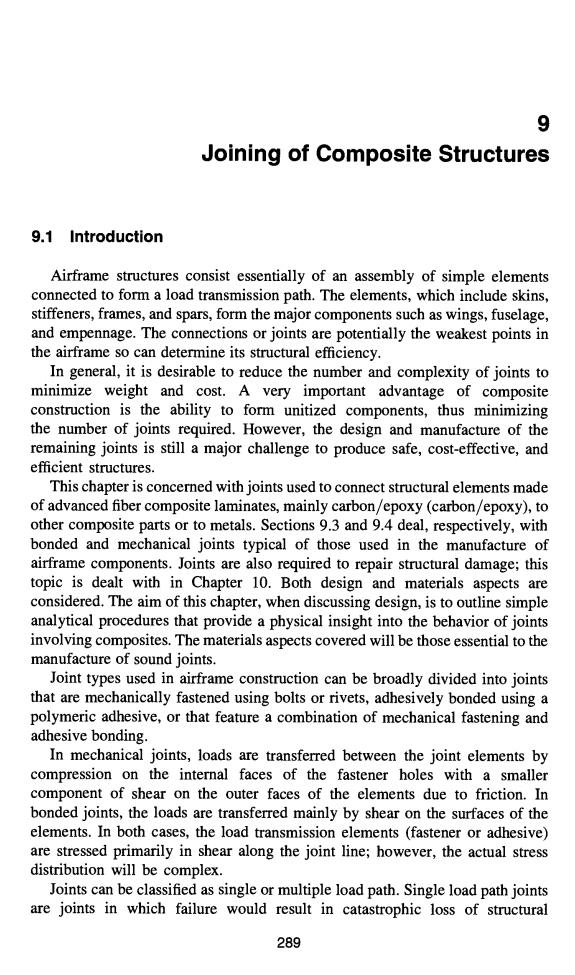正在加载图片...

9 Joining of Composite Structures 9.1 Introduction Airframe structures consist essentially of an assembly of simple elements connected to form a load transmission path.The elements,which include skins, stiffeners,frames,and spars,form the major components such as wings,fuselage, and empennage.The connections or joints are potentially the weakest points in the airframe so can determine its structural efficiency. In general,it is desirable to reduce the number and complexity of joints to minimize weight and cost.A very important advantage of composite construction is the ability to form unitized components,thus minimizing the number of joints required.However,the design and manufacture of the remaining joints is still a major challenge to produce safe,cost-effective,and efficient structures. This chapter is concerned with joints used to connect structural elements made of advanced fiber composite laminates,mainly carbon/epoxy (carbon/epoxy),to other composite parts or to metals.Sections 9.3 and 9.4 deal,respectively,with bonded and mechanical joints typical of those used in the manufacture of airframe components.Joints are also required to repair structural damage;this topic is dealt with in Chapter 10.Both design and materials aspects are considered.The aim of this chapter,when discussing design,is to outline simple analytical procedures that provide a physical insight into the behavior of joints involving composites.The materials aspects covered will be those essential to the manufacture of sound joints. Joint types used in airframe construction can be broadly divided into joints that are mechanically fastened using bolts or rivets,adhesively bonded using a polymeric adhesive,or that feature a combination of mechanical fastening and adhesive bonding. In mechanical joints,loads are transferred between the joint elements by compression on the internal faces of the fastener holes with a smaller component of shear on the outer faces of the elements due to friction.In bonded joints,the loads are transferred mainly by shear on the surfaces of the elements.In both cases,the load transmission elements (fastener or adhesive) are stressed primarily in shear along the joint line;however,the actual stress distribution will be complex. Joints can be classified as single or multiple load path.Single load path joints are joints in which failure would result in catastrophic loss of structural 2899 Joining of Composite Structures 9.1 Introduction Airframe structures consist essentially of an assembly of simple elements connected to form a load transmission path. The elements, which include skins, stiffeners, frames, and spars, form the major components such as wings, fuselage, and empennage. The connections or joints are potentially the weakest points in the airframe so can determine its structural efficiency. In general, it is desirable to reduce the number and complexity of joints to minimize weight and cost. A very important advantage of composite construction is the ability to form unitized components, thus minimizing the number of joints required. However, the design and manufacture of the remaining joints is still a major challenge to produce safe, cost-effective, and efficient structures. This chapter is concerned with joints used to connect structural elements made of advanced fiber composite laminates, mainly carbon/epoxy (carbon/epoxy), to other composite parts or to metals. Sections 9.3 and 9.4 deal, respectively, with bonded and mechanical joints typical of those used in the manufacture of airframe components. Joints are also required to repair structural damage; this topic is dealt with in Chapter 10. Both design and materials aspects are considered. The aim of this chapter, when discussing design, is to outline simple analytical procedures that provide a physical insight into the behavior of joints involving composites. The materials aspects covered will be those essential to the manufacture of sound joints. Joint types used in airframe construction can be broadly divided into joints that are mechanically fastened using bolts or rivets, adhesively bonded using a polymeric adhesive, or that feature a combination of mechanical fastening and adhesive bonding. In mechanical joints, loads are transferred between the joint elements by compression on the internal faces of the fastener holes with a smaller component of shear on the outer faces of the elements due to friction. In bonded joints, the loads are transferred mainly by shear on the surfaces of the elements. In both cases, the load transmission elements (fastener or adhesive) are stressed primarily in shear along the joint line; however, the actual stress distribution will be complex. Joints can be classified as single or multiple load path. Single load path joints are joints in which failure would result in catastrophic loss of structural 289